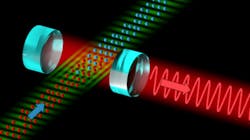European consortium to develop compact ultraprecise optical clocks using superradiant lasers
The iqClock program is the brainchild of physicists Florian Schreck from the University of Amsterdam (UVA) and Yeshpal Singh from the University of Birmingham. The consortium arose after both researchers decided to work on a shared goal: to improve and simplify ultraprecise optical atomic clocks. These clocks already exist in some laboratories; they can be accurate to on the order of 1 part in 1015, or about one second over the 14 billion year age of the universe. However, these lab-based clocks have two major drawbacks—they are extremely difficult to build and moreover are large, heavy, and not very robust. Schreck and Singh set out to build a consortium of European universities and businesses with the aim of making ultraprecise optical atomic clocks available to society.
Recent developments show that the concept of an optical atomic clock can be simplified. In current optical clocks, atomic vibrations set a very precise frequency that is then transferred to a laser. Tuning the laser frequency to that of the atoms is not easy, but physicists have now found a way to implement the idea more easily, by simply letting the vibrating atoms themselves form the laser beam—a construction that has been dubbed a superradiant laser. In other words, the laser coherence is "stored" in the laser gain medium, rather than in the light field itself.
This double use of the same atoms should make it much easier to construct optical atomic clocks, as the atoms provide light that is not only very stable, but also automatically has the correct frequency.
Industrial optical atomic clocks
So far, superradiant clocks have never been built. However, the main building block, a continuous source of ultracold strontium atoms only a few millionths of a degree above absolute zero, was recently realized by Florian Schreck's team. At the same time, Yeshpal Singh had suggested an initiative to develop industrial optical atomic clocks, planning to reduce the large size and fragility of the existing clocks.
Turning a proof of concept into actual working clocks is a long process, though, and one that requires close collaboration between science and industry. Schreck, Singh, and Kai Bongs, Birmingham physicist and director of the UK National Hub for sensors and metrology, decided to team up with a large group of colleagues from Torun, Copenhagen, Vienna, and Innsbruck to see if such a collaboration could be realized.
On the industry side, several partners were equally interested in developing the ideas: Teledyne e2v, Chronos, and British Telecom in the UK, Toptica in Germany, NKT Photonics in Denmark, and Acktar in Israel. With such substantial interest among both academic and industrial partners, the decision was made to set up a broad European research consortium with the goal of bringing optical clocks closer to the market. The consortium was subsequently financed as one of the first projects in the context of the Flagship Initiative for quantum technologies, a broad 10-year program funded by the European Union to the tune of one billion euros. Out of this budget, the iqClock consortium, as the new collaboration was named, was funded for the next three years for a total of 10 million euros.
The consortium's aim is to make the optical clock technology fully transportable, so that by the end of the 10-year program it can be used in satellites, for example. This is not an easy process, but the benefits are enormous. Once the new clocks have become commonplace, they can be used to increase navigation system precision to the scale of centimeters, which would revolutionize the way in which we measure the Earth. In astronomy, atomic clocks are used to synchronize telescopes all over the planet into what is effectively one giant telescope the size of Earth. Transportable optical clocks are also useful for detecting gravitational waves by using satellites that are many thousands of kilometers apart. A more practical application lies in better synchronization of telecommunication networks, increasing their performance. And, of course, when new technology becomes available on a wide scale, industry will inevitably find novel ways to use it.
For more info, see https://www.iqclock.eu/.
Source: https://www.alphagalileo.org/en-gb/Item-Display/ItemId/170147?returnurl=https://www.alphagalileo.org/en-gb/Item-Display/ItemId/170147
About the Author
John Wallace
Senior Technical Editor (1998-2022)
John Wallace was with Laser Focus World for nearly 25 years, retiring in late June 2022. He obtained a bachelor's degree in mechanical engineering and physics at Rutgers University and a master's in optical engineering at the University of Rochester. Before becoming an editor, John worked as an engineer at RCA, Exxon, Eastman Kodak, and GCA Corporation.

